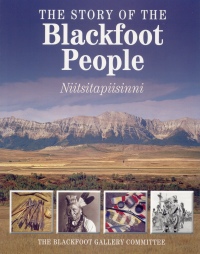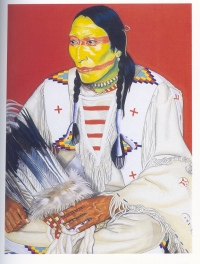| ________________
CM . . .
. Volume XX Number 7. . . .October 18, 2013 
 |
The Story of the Blackfoot People: Niitsitapiisinni.
The Blackfoot Gallery Committee.
Richmond Hill, ON: Firefly Books, 2013.
104 pp., pbk., $19.95.
ISBN 978-1-77085-181-8.
Subject Heading:
Siksika Indians-History.
Grades 4 and up / Ages 9 and up.
Review by Gail de Vos.
**** /4
|
| |
|

excerpt:
Niitawashsi is our name for our territory. Our ancient stories tell us that we were given this territory by Ihtsi-pai-tapi-yopa, our Creator and Essence of Life. These stories assert our right to exist here.
Our traditional territory extended from Ponoka-si-sahta (Elk River, the North Saskatchewan River) south to Otahkoi-tah-tayi (the Yellowstone River). We lived along the eastern slopes of the Rocky Mountains and eastward beyond Omahski-spatsi-koyii (the Great Sand Hills in what is now Saskatchewan). It is an immense land, with some of the richest natural resources in the world.
We knew every detail of this land. Our people traveled constantly throughout it, and their trails were well marked along the grasslands. They lived by hunting game and collecting plants. By moving camp frequently, they were able to avid depleting the resources in any one area. Our people knew the places were different plants grew and where game was plentiful. Their lives were nomadic, but their movement were not aimless: they always traveled with a purpose. (p. 12)
One of our ancient stories tells of the time Napi gave his buffalo robe to a big rock and then took it back again. No animal could stop this rock as it chased Napi. Finally, two small birds dived at the rock and burst it to pieces. The big rock near the town of Okotoks, Alberta, is part of the rock that chased Napi. The rest of the debris is scattered southward along the foothills of Alberta and Montana. The name Okotoks comes from the Blackfoot word Ohkohtok, which means rock. (Sidebar, p. 16)
Filled to the brim with photographs, illustrations, stories, and information collected by the Glenbow Museum from elders for their exhibit of “The Blackfoot Legacy”, the book was originally published in 2001. Since that time, the value of this legacy and the accompanying information has become even more important to be shared, not only in the traditional territory of the Blackfoot in Canada and the United States, but with people residing outside those borders.
 My living in Central Alberta, slightly north of the demarcation line of the North Saskatchewan River for the traditional territory of the Blackfoot, means that I am much more familiar with Cree traditions and cultures and appreciate the information gained from reading this book even more. I particularly appreciated that, while the history and traditions were a major focus of the presented information, there was every indication that the Blackfoot people, culture and traditions were vibrant and relevant in today’s contemporary society. I also appreciated that the book included information about the entire territory which stretches beyond the artificial current borders established by governmental officials. My living in Central Alberta, slightly north of the demarcation line of the North Saskatchewan River for the traditional territory of the Blackfoot, means that I am much more familiar with Cree traditions and cultures and appreciate the information gained from reading this book even more. I particularly appreciated that, while the history and traditions were a major focus of the presented information, there was every indication that the Blackfoot people, culture and traditions were vibrant and relevant in today’s contemporary society. I also appreciated that the book included information about the entire territory which stretches beyond the artificial current borders established by governmental officials.
The information and stories presented in the seven chapters remind the reader of the foundation and growth of this proud and germane nation. Readers explore the way of life of the Blackfoot, their world view, their coexistence with each other and their neighbours, the physical territory, and the end of the buffalo days. An extensive glossary of Blackfoot terms, image credits and bibliography and an index complete the package. Colour, copious photographs, both in colour and black-and-white, creative and aesthetic layouts, along with eclectic sidebars and quotes offer readers an enlightening and effective expedition into the past and a perceptive and purposeful pathway for a broader understanding and appreciation of the Blackfoot people.
Highly recommended for all collections. Also recommended: Glenbow Website: http://www.glenbow.org/blackfoot/en/html/index.htm
Highly Recommended.
Gail de Vos teaches at the School of Library and Information Studies for the University of Alberta and San Jose State University. She is the author of nine books on storytelling and folklore.

To comment
on this title or this review, send mail to cm@umanitoba.ca.
Copyright © the Manitoba Library Association. Reproduction for personal
use is permitted only if this copyright notice is maintained. Any
other reproduction is prohibited without permission.
NEXT REVIEW |
TABLE OF CONTENTS FOR THIS ISSUE
- October 18, 2013.
AUTHORS |
TITLES |
MEDIA REVIEWS |
PROFILES |
BACK ISSUES |
SEARCH |
CMARCHIVE |
HOME |

 My living in Central Alberta, slightly north of the demarcation line of the North Saskatchewan River for the traditional territory of the Blackfoot, means that I am much more familiar with Cree traditions and cultures and appreciate the information gained from reading this book even more. I particularly appreciated that, while the history and traditions were a major focus of the presented information, there was every indication that the Blackfoot people, culture and traditions were vibrant and relevant in today’s contemporary society. I also appreciated that the book included information about the entire territory which stretches beyond the artificial current borders established by governmental officials.
My living in Central Alberta, slightly north of the demarcation line of the North Saskatchewan River for the traditional territory of the Blackfoot, means that I am much more familiar with Cree traditions and cultures and appreciate the information gained from reading this book even more. I particularly appreciated that, while the history and traditions were a major focus of the presented information, there was every indication that the Blackfoot people, culture and traditions were vibrant and relevant in today’s contemporary society. I also appreciated that the book included information about the entire territory which stretches beyond the artificial current borders established by governmental officials.